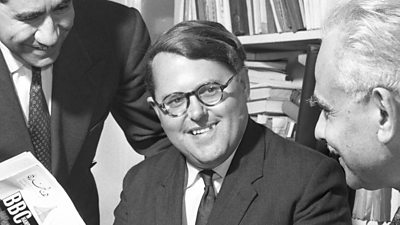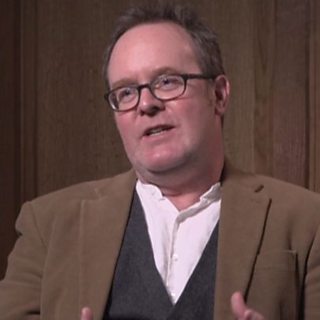Although many of the ����ý’s pioneers have published their memoirs over the years, the first attempt to create a detailed and all-encompassing history of the broadcaster did not begin until 1957, a full thirty-five years after it had been launched.
It was then that Asa Briggs, a young Professor of History at Leeds University, was approached by the ����ý’s Director-General Ian Jacob. Briggs saw Jacob’s interest as the ����ý recognising that ‘had to look at its own past’ in order to understand properly its present-day mission, and that with many of the people who’s been involved in the 1920s now rather old the time left to gather first-hand accounts was fast running out.

The choice of Asa Briggs as the first ‘official’ historian was intriguing. When I spoke to him about his role in 2008, he recalled how his colleagues at the time saw him as a scholar of labour or urban history: they were rather surprised he’d accepted the ����ý’s commission. ‘I think they thought that it was a bit of a waste of time’. Briggs, though, was passionate about widening access to education and deeply interested in the role technology played in that process. During the war, he’d sat before the ����ý microphone, contributing to educational programmes for Allied troops. He’d recently started appearing on television, too. Culture, he decided, ‘expressed itself through programmes and personalities’, and the people he’d come across in the studios and production offices seemed ‘interesting’. He didn’t say whether or not his wartime experience of working at Bletchley Park on cracking the Enigma code had also attracted him to the task of trying to unravel the unspoken codes and values of professional life in places like Broadcasting House and Television Centre, but it can’t be ruled out.
When it came to getting down to researching the ����ý’s history in 1958, some remarkable insights into Briggs’ experience are to be found an interview he recorded with Frank Gillard for the ����ý Oral History project back 1991.
In this recording, he reveals how few resources there were to begin with: the machinery for supporting an institutional history of the Corporation wasn’t yet in place. He also offers a vivid account of his dealings with John Reith - a famously temperamental figure whose support for the project would be vital - including the moment when he had to persuade the former Director-General not to destroy his own diaries. Gillard begins the interview by asking how much independence Briggs had as ‘official’ historian:
Briggs maintained a dislike for the term ‘official historian’, agreeing with A.J.P. Taylor’s accusation that it too often implied being an apologist. He preferred to think of himself as writing ‘institutional history’, an approach which, in his mind, was not just about policies and structures but about the people who worked inside and their relationship with wider society: it was about values, behaviour, tribal loyalties and conflicts, feelings. It was also an approach which promised to be sympathetic though not uncritical.
It took thirty-five years, five volumes, and nearly 4,000 pages for Briggs to complete his mission. But just as the work came to an end in 1992, budget cuts meant the closure of the ‘History Unit’ which had been established by the ����ý to support his research. It was a decision that seemed to cut the Corporation off from its own rich and complex past. And it was to be several more years before the decision was reversed and a successor appointed to take up the challenge of providing a new, sixth volume.
Jean Seaton, a media historian at the University of Westminster, was charged with telling the story of the ����ý in the late-1970s and early-1980s – a period which coincided with a particularly turbulent period in UK history: civil strife in Northern Ireland, the Falklands War, industrial disputes, the Thatcher Government. Seaton wanted an approach which took full account of this political climate. All the Corporation’s actions, she felt, had to be understood ‘in the context of the nation of that period’. She also decided to replace the chronological approach of the previous five volumes with something more thematic in structure.
Nevertheless, when interviewed soon after the publication of her book, Pinkoes and Traitors: The ����ý and the Nation1974-1987, she recalled how Asa Briggs’s work had had a profound impact earlier in her career - showing her how broadcasting history might be done in a way that stood apart from the usual ‘media studies’ approach:
Jean Seaton mentioned briefly in her interview the significance of the ����ý’s own Oral History collection in researching the Corporation’s history. This remarkable resource was created too late to help Asa Briggs when he began his work: it was only in 1972 that the idea was conceived of systematically interviewing key staff about their careers at the ����ý – the programmes they made, the culture of their department, the characters they worked alongside, what they witnessed happening behind-the-scenes during key moments in the Corporation’s turbulent history.
The main figure involved in creating this rich new resource was the former War Correspondent Frank Gillard, who’d retired from his last role at the Corporation – as a senior manager in Radio – in 1969.
Over the next two decades and more, it was Gillard himself who conducted many of the interviews which are now kept in the ����ý’s Oral History Collection. And before he died in 1998, he made sure that he had deposited a recording of his own: his memories, not just of his extraordinarily varied career at the ����ý but also the project he founded – and what he believed to be the unique qualities of an oral history approach:
There are now several hundred interviews in the ����ý Oral History collection, with more being gathered every year. And as Gillard explained in his interview, like Briggs before him, he experienced no editorial interference from the ����ý when it came to the choice of interviewee or the questions he would ask them.
Even so, ever since the project began in the early-1970s the Collection has only been accessible to a chosen few: the ����ý’s own programme-makers or those enjoying the status of official ����ý historians. That’s now changing.
It was when looking ahead to the 2022 Centenary, that the decision was taken at a high level in the Corporation to make the Collection more accessible to a wider audience. In 2015, the ����ý’s Head of History, Robert Seatter, initiated a long-term project with the University of Sussex, which would see a large part of the Collection digitized, curated, and made available to the general public. I’ve been directly involved with that project. As I explained in this short interview back in 2015, I see the benefits of oral history as extending well beyond providing a first-hand account, valuable though that is. There is extra value in actually hearing and seeing the person giving that account:
These webpages, tracing the 100 Voices that Made the ����ý, are a direct result of the Corporation’s collaboration with Sussex. And they point to a new stage in ‘the history of the history of the ����ý’ – one which attempts to ‘democratise’ that history by opening-up a treasure trove of archival resources from which a multitude of histories, both official and unofficial, can be created in the years to come.
Nor is 100 Voices that Made the ����ý the final stage of this shift. During the ����ý’s Centenary year of 2022, hundreds more interviews from the ����ý’s Oral History Collection will be made fully accessible through the ‘Connected Histories of the ����ý’ project based at the University of Sussex. So watch this space. I hope very much that it will be a resource that Asa Briggs himself – someone who was, after all, not just the founding father of ����ý history but one of our former Vice-Chancellors at Sussex – would have admired if he could have seen it in action.
Written by David Hendy, Emeritus Professor (Media and Film) School of Media, Arts and Humanities, University of Sussex.
David Hendy’s latest book, The ����ý: A People’s History, was published by Profile Books in January 2022.

